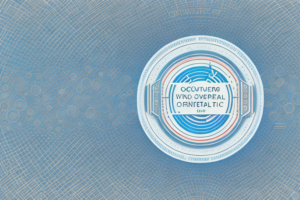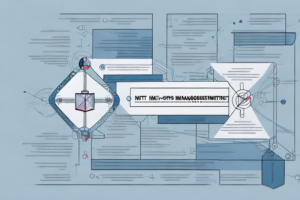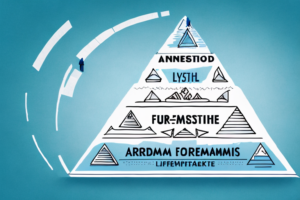How many steps are there in the Risk Management Framework RMF )?
8 min read
A multi-layered pyramid
The Risk Management Framework (RMF) is a critical component of effective cybersecurity. It provides a structured process for identifying, assessing, and managing risks to an organization’s information system. But how many steps are there in the RMF, and what does each step involve? In this article, we will explore the basics of the RMF, its six key steps, common challenges, best practices, and future trends.
Understanding the basics of Risk Management Framework
The RMF is a guiding document developed by the National Institute of Standards and Technology (NIST) to help organizations manage their cybersecurity risks. It emphasizes a holistic approach to risk management that addresses all aspects of an information system, including hardware, software, data, and personnel. The RMF is applicable to all federal agencies as well as private sector organizations seeking to strengthen their cybersecurity posture.
One of the key benefits of using the RMF is that it provides a standardized approach to risk management. This means that organizations can use the same framework to assess and manage risks across different systems and environments. It also helps to ensure consistency in risk management practices, which can be particularly important for organizations that operate in highly regulated industries.
Another important aspect of the RMF is that it is a continuous process. This means that organizations must regularly assess and update their risk management strategies to ensure that they remain effective in the face of evolving threats and changing business needs. By adopting a continuous approach to risk management, organizations can better protect their information systems and reduce the likelihood of cyber attacks and data breaches.
The importance of Risk Management Framework in cybersecurity
The RMF is essential in ensuring that an organization’s information system is secure. The framework provides a structured process for identifying potential threats and vulnerabilities, assessing the likelihood and impact of those risks, and implementing appropriate security controls to minimize the risks. By following the RMF, organizations can create a comprehensive and effective cybersecurity plan that is customized to their specific needs and goals.
One of the key benefits of using the RMF is that it helps organizations to prioritize their cybersecurity efforts. By identifying the most critical assets and systems, organizations can focus their resources on protecting those areas that are most vulnerable to attack. This approach ensures that limited resources are used effectively and efficiently, and that the organization is better prepared to respond to cyber threats.
Another advantage of the RMF is that it provides a common language and framework for communication between different stakeholders. This is particularly important in large organizations where different departments may have different priorities and objectives. By using the RMF, all stakeholders can work together to develop a cohesive cybersecurity strategy that is aligned with the organization’s overall goals and objectives.
Key objectives of the Risk Management Framework
One of the primary objectives of the RMF is to enable organizations to reduce their cybersecurity risks to an acceptable level. The framework establishes a set of guidelines and procedures to help organizations identify, categorize, and prioritize their risks. The RMF also helps organizations to select and implement appropriate security controls to mitigate their risks. Finally, the RMF provides a continuous monitoring process to ensure that the security controls are effective and that the organization remains in compliance with relevant regulations and standards.
Another important objective of the RMF is to promote a risk management culture within organizations. This involves creating awareness among employees about the importance of cybersecurity and their role in protecting the organization’s assets. The RMF encourages organizations to develop and implement training programs to educate employees on cybersecurity best practices and to ensure that they are aware of the risks associated with their job functions. By promoting a risk management culture, organizations can create a more secure environment and reduce the likelihood of cyber attacks.
Overview of the six steps involved in RMF
The RMF consists of six distinct steps that guide organizations through the risk management process:
- Step 1: Categorizing Information System
- Step 2: Selecting Security Controls
- Step 3: Implementing Security Controls
- Step 4: Assessing Security Controls
- Step 5: Authorizing Information System Operation
- Step 6: Continuous Monitoring and Maintenance
It is important to note that the RMF is not a one-time process, but rather a continuous cycle of risk management. This means that organizations must regularly assess and update their security controls to ensure they are still effective in mitigating risks. Additionally, the RMF is not just limited to information systems, but can also be applied to physical security and other areas of an organization’s operations.
Step 1: Categorizing Information System
The first step in the RMF process is to categorize the information system. This involves identifying the system’s security objectives, the types of information it processes, and the potential consequences of a security breach. This step establishes a baseline for the rest of the RMF process and helps to ensure that risk management efforts are focused on the most critical assets.
During the categorization process, it is important to involve all stakeholders who have a vested interest in the information system. This includes system owners, users, and IT personnel. By involving all stakeholders, a comprehensive understanding of the system’s security objectives and potential risks can be achieved. Additionally, this step may involve conducting a risk assessment to identify potential threats and vulnerabilities that could impact the system’s security posture.
Step 2: Selecting Security Controls
The second step in the RMF process is to select appropriate security controls to protect the information system. This involves identifying and selecting controls from a set of baseline security controls established by NIST. The selected controls should be appropriate to the system’s categorization and provide effective protection against relevant threats and vulnerabilities.
It is important to note that the selection of security controls should not be a one-time event. As the information system and its environment evolve, the effectiveness of the selected controls should be regularly assessed and adjustments made as necessary. This ongoing process of monitoring and updating security controls is known as continuous monitoring and is a critical component of the RMF process.
Step 3: Implementing Security Controls
In this step, the selected security controls are implemented to protect the information system. This may involve configuring hardware and software settings, updating policies and procedures, and training staff on the use of the controls. The goal is to ensure that the controls are correctly implemented and are functioning effectively.
One important aspect of implementing security controls is to regularly monitor and test them to ensure that they are still effective. This can involve conducting vulnerability scans, penetration testing, and other assessments to identify any weaknesses or gaps in the controls. Regular testing can help to identify and address any issues before they can be exploited by attackers.
Another important consideration when implementing security controls is to ensure that they are aligned with the organization’s overall risk management strategy. This means that the controls should be designed to address the specific risks and threats that the organization faces, and should be prioritized based on the potential impact of a security breach. By aligning security controls with risk management, organizations can ensure that they are making the most effective use of their resources to protect their information assets.
Step 4: Assessing Security Controls
Once the security controls are implemented, an assessment is conducted to ensure that they are effective in mitigating risks to the information system. This assessment may involve vulnerability scanning, penetration testing, and other testing methodologies to identify weaknesses in the security controls. Based on the results of the assessment, adjustments may be made to the controls to address identified weaknesses and improve their effectiveness.
It is important to note that security controls should be regularly assessed and updated to ensure that they remain effective against new and evolving threats. This may involve conducting assessments on a regular basis, such as quarterly or annually, or in response to significant changes to the information system or threat landscape.
Additionally, it is important to involve all relevant stakeholders in the assessment process, including IT staff, security personnel, and business leaders. This can help ensure that the assessment is comprehensive and that any identified weaknesses are addressed in a timely and effective manner.
Step 5: Authorizing Information System Operation
After the security controls have been implemented and assessed, the information system is authorized to operate. This involves the approval of key stakeholders based on the evidence of effective security controls and risk management. Authorization to operate is an important milestone in the RMF process, as it indicates that the organization has taken all appropriate measures to protect its information system.
Once the information system is authorized to operate, it is important to continuously monitor and maintain the security controls to ensure that they remain effective. This includes conducting regular security assessments, implementing software updates and patches, and providing ongoing security training to employees. By maintaining a strong security posture, organizations can reduce the risk of security incidents and protect their sensitive information from unauthorized access or disclosure.
Step 6: Continuous Monitoring and Maintenance
The final step in the RMF process is to continuously monitor and maintain the information system. This involves ongoing risk assessments, monitoring of security controls, and maintenance of policies and procedures. The purpose of this step is to ensure that the information system remains secure over time and that any new risks or vulnerabilities are promptly identified and addressed.
Common challenges faced during RMF implementation
Implementing the RMF can present several challenges for organizations. One common challenge is selecting appropriate security controls that are specific to the organization’s needs and goals. Another challenge is integrating the RMF into existing cybersecurity processes and ensuring that relevant stakeholders are engaged throughout the process. In addition, the RMF requires ongoing monitoring and maintenance, which can be difficult to sustain over time.
Best practices for successful RMF execution
To ensure successful RMF execution, organizations should establish clear goals and objectives for the risk management process and engage all relevant stakeholders early in the process. It is also essential to maintain open communication with stakeholders throughout the process and tailor the RMF to the organization’s specific needs. Finally, establishing a continuous monitoring process can help to ensure that the information system remains secure over time.
How to integrate RMF into your organization’s cybersecurity plan
To integrate the RMF into an organization’s cybersecurity plan, it is important to establish a clear understanding of the RMF process and its requirements. This may involve training staff on the RMF and its key components, seeking external guidance from consultants or industry experts, and collaborating with other organizations that have successfully implemented the RMF. Ultimately, the goal is to develop a customized RMF process that aligns with the organization’s specific needs and goals.
Future trends and developments in the RMF process
The RMF is an evolving process that adapts to changing cybersecurity threats and technological advancements. One emerging trend in the RMF process is the use of automated tools and technologies to streamline the risk management process and enhance the effectiveness of security controls. Additionally, the RMF is being integrated into broader cybersecurity frameworks, such as the Cybersecurity Information Sharing Act (CISA) and the Cybersecurity Framework developed by the National Institute of Standards and Technology (NIST).
In conclusion, the RMF is a critical component of effective cybersecurity, providing a structured process for identifying, assessing, and managing risks to an organization’s information system. The framework consists of six key steps that guide organizations through the risk management process, from categorizing the information system to continuous monitoring and maintenance. By following the RMF, organizations can create a comprehensive and effective cybersecurity plan that is customized to their specific needs and goals, and that remains up-to-date with emerging trends and technologies.



